Last updated: February 26, 2025
Article
Edward Moore Kennedy: A Legacy of Public Service
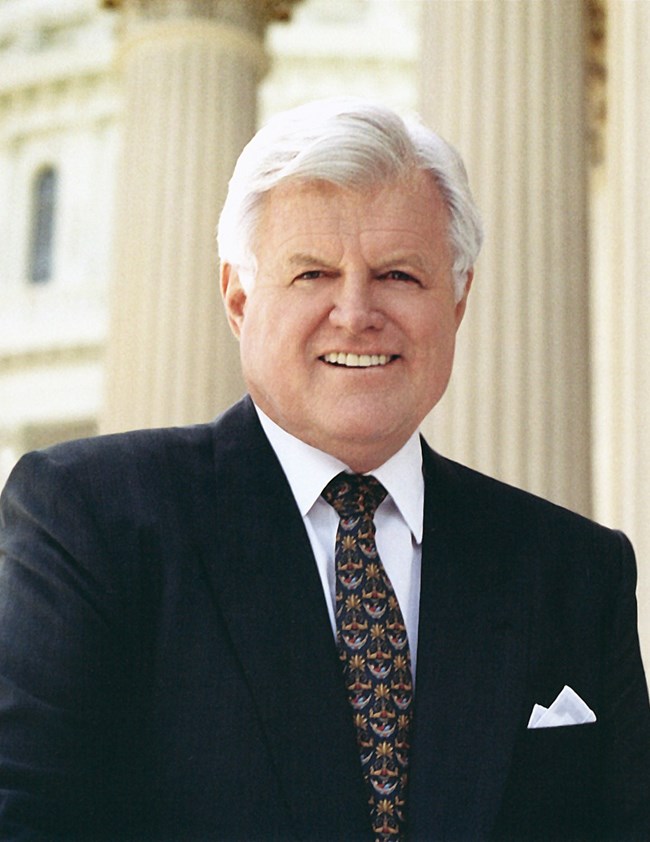
United States Senate, the image is in the public domain.
While he was often compared to his older brothers John and Robert, whose mystique captivated the American public, Ted Kennedy not only helped carry forth their legacies but carved his own on the American political landscape. He became a champion for the underprivileged and, toward the end of the twentieth century, was the most important voice for traditional liberalism. Elected nine times, Kennedy was one of the longest serving and most consequential U.S. Senators in American history.
“The work goes on, the cause endures, the hope still lives, and the dream shall never die.”
– Senator Edward M. Kennedy, 1980 Democratic National Convention
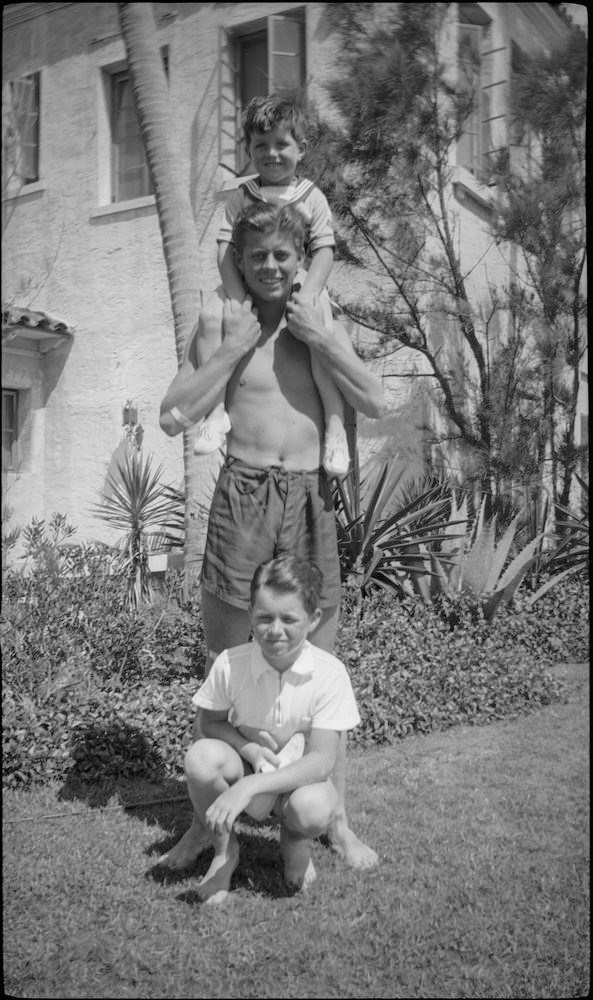
Photographer unknown. Courtesy: John F. Kennedy Library Foundation. Kennedy Family Collection. John F. Kennedy Presidential Library. KFC586N
Early Life and Family Influences
On February 22, 1932, Joseph and Rose Kennedy welcomed their ninth child into the world at St. Margaret’s Hospital in Dorchester, MA. They named their son Edward Moore Kennedy after Mr. Kennedy’s secretary and close family friend, Edward Moore. As the youngest of his siblings, "Teddy" was the adorable baby brother who everyone showered with attention. He was energetic, friendly, outgoing, and loved to make others laugh. Teddy revered his older brothers Joe Jr., Jack, and Bobby, and aspired to be like them and follow in their footsteps. Ted placed enormous pressure on himself to live up to the standards set by them and public sentiment alike.
Ted’s childhood was shaped by a demanding family with high expectations. Mr. and Mrs. Kennedy had their own strong ambitions and encouraged their children to be like-minded. His parents also possessed a very keen sense of public image making and as their wealth, fame, and family grew, an outward appearance of perfection for themselves and their children became paramount.
From strict regulation of the children's diets, to orthodontics, to placement in private schools, and an emphasis on athleticism, the Kennedy children were expected to be models of perfection. Mrs. Kennedy later said “I was happy, optimistic, and proud. I had made up my mind to raise my children as perfectly as possible. What greater aspiration and challenge are there for a mother than the hope of raising a great son or daughter?”
Mrs. Kennedy took every opportunity to educate her children. Ted later remarked, "Mother was...Our Pied Piper into the world of ideas. She led us on educational outings to the museums and to concerts, to Concord and Bunker Hill and the Old North Church, rattling out and providing math challenges to us along the way...She was moderator of our topical dinner table conversations, the topics - geography one night, the front page headlines the next… announced in advance on cards that she wrote out and pinned to a billboard near the dining room."
Mr. Kennedy also played a large role in preparing his children for a successful future. He expected them to be tough and independent, often reminding them that Kennedys never cry and that second place was not good enough. He led debates around the dinner table and encouraged competition. Ted later reflected, "We grew up in an atmosphere of high-spirited competitiveness." Despite the family's wealth, the children were taught to be modest and develop a sense of responsibility for those less fortunate than themselves.
Most crucially, Mr. Kennedy taught his children that family meant everything and to look out for one another. He also made certain that his children were being raised with access to a rich array of life experiences. When Ted was just six years old, his father moved the entire family to London after he was appointed to serve as ambassador to Great Britain by President Franklin Roosevelt. The family regarded their time in England with a special fondness. With the British press eager to feature them in publications, their image was further galvanized at home and abroad.
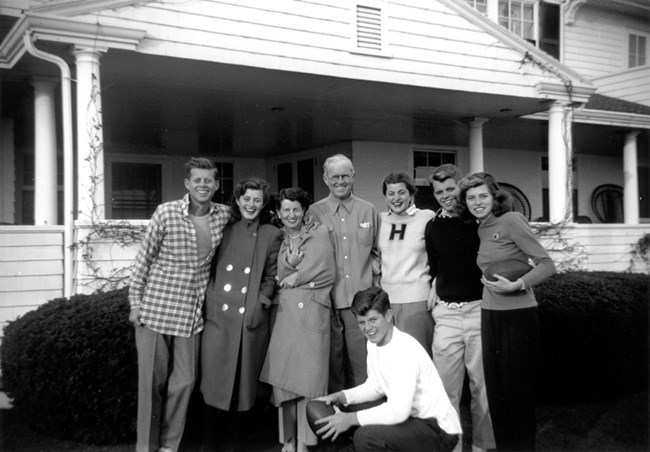
John F. Kennedy Presidential Library and Museum, Boston. PC180
Although he regarded his childhood favorably, Ted struggled in school. His family constantly traveled and Ted was often pulled from one school and placed in another, during the same academic year. This led to inconsistencies in his learning, poor grades, and short-lived childhood friendships. By the time he was eleven, Ted had attended nearly a dozen different schools. He finished out his four years of high school at Milton Academy in Milton, MA, a preparatory boarding school just outside of Boston. In 1950 he enrolled at Harvard University, the same school his father and older brothers had attended.
At Harvard, Ted found special enjoyment in football, playing as an offensive and defensive end, and eventually earned a varsity letter. This was an accomplishment that, of all four Kennedy boys, only he and Bobby achieved. Nearing the end of his freshman year, Ted was in danger of failing his Spanish class and had a teammate take his final exam for him. The boys were caught cheating and thrown out of school but allowed to return after two years of good behavior.
To repair his image, and to follow in his older brothers' footsteps of military service, Ted enrolled in the U.S. Army in 1951. He completed Basic Training at Fort Dix, NJ, and his Advanced Individual Training, as a military policeman, at Fort Gordon, GA. Ted's military experience was eye-opening. It was likely the first time that he interacted with those outside of the privileged class to which he was accustomed. Ted was discharged from the Army in 1953 and returned to Harvard with a renewed sense of purpose. In 1956, he graduated from Harvard with a bachelor's degree in history and government. He then enrolled in law school at the University of Virginia, his brother Bobby's alma mater, and earned his own law degree in 1959.
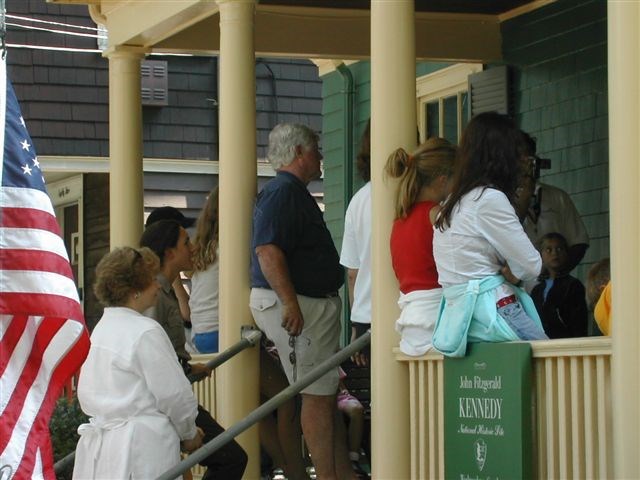
NPS.
In 1958, Ted married Joan Bennett and the couple had three children together: Kara, Ted Jr., and Patrick. When Ted Jr. was twelve, he was diagnosed with bone cancer and his right leg was amputated. This tragedy further impassioned Ted Sr.'s commitment to improving healthcare for all in the years to follow. Joan and Ted divorced in 1982.
Between the loss of family members, complicated personal issues, and the end of his first marriage, Ted sometimes went down self-destructive paths which were widely publicized by the media. He often found solace in being a surrogate father to his late brothers' children and organized outings for his large extended family, like a 2002 visit to John Fitzgerald Kennedy National Historic Site.
In 1992, Ted began a new marriage with corporate lawyer Victoria Reggie. Vickie Kennedy is often credited with helping Ted to turn his life around and salvage his political career.
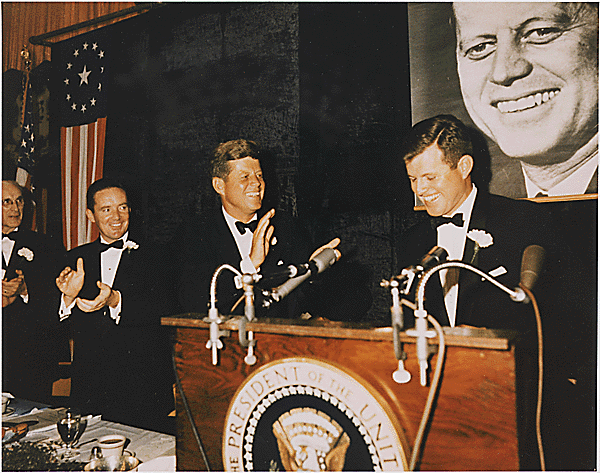
Photographer: Cecil Stoughton. Courtesy: National Archives. 194272
On the Campaign Trail
In 1958, Ted successfully managed his brother John's U.S. Senate campaign. Two years later, Ted took charge of Jack's presidential campaign in eleven Western states. Delegates there were inclined to nominate an established party figure rather than someone like the young newcomer John Kennedy. Ted adopted a few unconventional strategies to sway their votes. In Montana, he earned the opportunity to speak to a crowd after lasting seven seconds on a bucking bronco. Another time, when campaigning to garner Wisconsin’s crucial swing-state votes, he wowed crowds once again by completing a ski-jump run that sent him 190 feet into the air.
Ted Kennedy’s innovative outreach and growing strength as a public speaker captured the nation’s attention. Many noted that Ted naturally possessed the attributes of a politician early on and likened him to his gregarious and personable maternal grandfather, John "Honey Fitz" Fitzgerald, the former Mayor of Boston, a Massachusetts State Senator, and U.S. Congressman. When John grew hoarse after a series of speaking engagements in West Virginia, Ted stepped in. He spoke so well that John felt compelled to remind his 28-year-old brother that he could not be elected President until he was 35. In the process of helping his brother win the presidency, Ted increased his own viability as a candidate for political office.
Shortly before his inauguration, John advised Ted to run for the Senate seat that he was vacating. When Ted entered the 1962 race, he applied the vigorous techniques he had learned while campaigning for his brother. These efforts paid off when Ted Kennedy won both the primary and general elections by decisive margins.
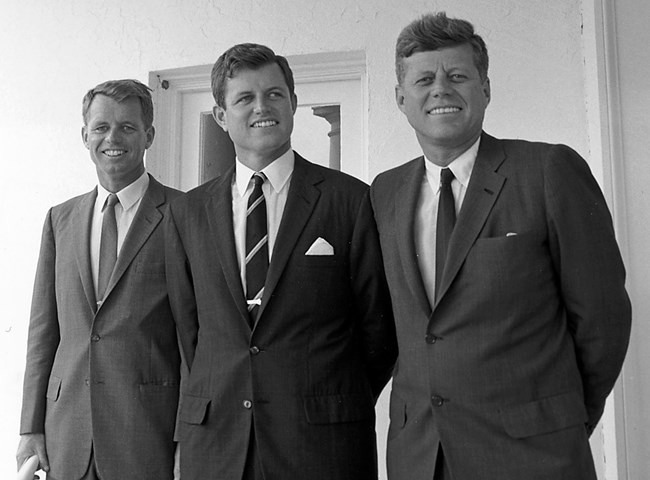
Photographer: Stoughton, Cecil W. Courtesy: John F. Kennedy Presidential Library and Museum, Boston, MA. ST-398-3-63
Carrying the Torch
During his first year as a U.S. Senator, Ted Kennedy often spent evenings in the White House swimming pool with President Kennedy and Attorney General Robert Kennedy, seeking both advice and companionship. At the same time, the Senator distinguished himself from the President by adopting a more aggressive stance toward the decade’s most contentious political issue: civil rights for African Americans. While President Kennedy avoided engaging directly with the 250,000 activists who marched on Washington in 1963, Senator Kennedy spent the day receiving demonstrators in his office. This gesture set the precedent for his commitment to supporting underserved populations throughout his career.
Senator Kennedy was presiding over the Senate when he received the news that President Kennedy had been shot on November 22, 1963. This moment redefined his political career as he worked tirelessly to shape and fulfill his older brother’s legacy in the years to come. In April 1964, Senator Kennedy gave a powerful speech in favor of the Civil Rights Act. In this speech he stressed that his brother’s death could teach Americans that “we should not hate but love one another, we should use our powers not to create conditions of oppression that lead to violence, but conditions of freedom that lead to peace.” Two months later, the Civil Rights Act became law. During the 1960s Ted Kennedy also worked with his brother Robert, now a Senator from New York, to pass legislation that abolished national immigration quotas, paving the way for newly diverse generations to flourish in America. Their shared passion for this issue made it even more devastating when Robert was assassinated in 1968 at the height of his presidential campaign.
In July of 1969, Senator Kennedy travelled to Chappaquiddick island, off the coast of Massachusetts to attend a gathering with some of the staff that had worked on Bobby’s campaign. Later that evening, Kennedy was involved in an automobile accident, resulting in a wrong turn that sent his car plunging into the water. Kennedy was able to free himself from the car but was unable to rescue Mary Jo Kopechne. He fled the scene and did not call in the accident immediately. Kennedy’s handling of the aftermath of this incident in his words “haunt[ed] him every day of his life.”
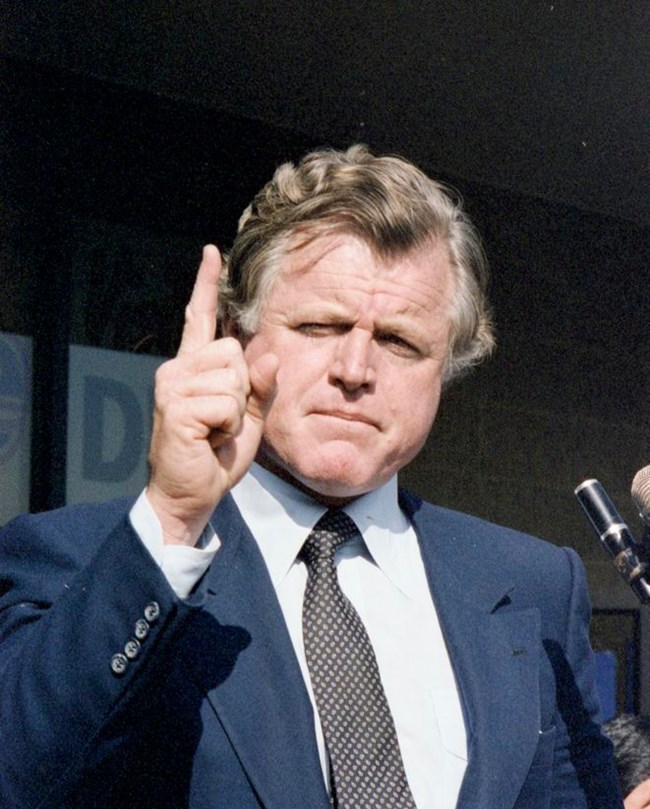
Sven Walnum, The Sven Walnum Photograph Collection. John F. Kennedy Presidential Library and Museum, Boston, MA. SWPC-EMK-C005-016
"Lion of the Senate"
Determined to maintain his family’s legacy of public service, Senator Ted Kennedy became one of the nation’s longest serving and most influential senators. The affectionate sibling rivalry that characterized his childhood helped him develop the skills essential for effective bipartisan leadership. He did not hesitate to reach across the aisle and compromise in order to get the job done, but he stoically stood his ground even when his opinions were unpopular.
Throughout his career, Senator Kennedy also remained committed to advancing the unfinished work of his older brothers. As President, John Kennedy laid the groundwork for legislation to establish Medicare, ensuring affordable healthcare to elderly and disabled Americans. Senator Kennedy sought to broaden the scope of affordable healthcare to include all Americans, a goal achieved posthumously in 2010. Similarly, Robert Kennedy fought ardently as Attorney General to end racial discrimination. Senator Kennedy contributed to this goal by supporting a busing program that integrated the Boston Public Schools. He also supported legislative efforts to protect and secure rights for women, immigrants, military personnel and their families, Americans with disabilities, gay and lesbian Americans, and many other groups.
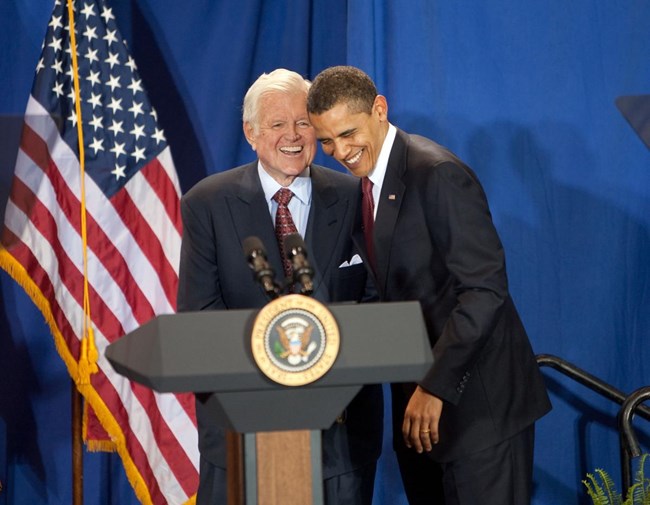
National Archives (P042109LJ-0188)
For the People
Senator Kennedy’s commitment to ensuring the equal rights of all Americans paralleled his dedication to protecting public spaces where all Americans could reflect on their nation’s history. The senator succeeded in achieving inclusion in the National Park System for a range of historic sites in Massachusetts, including the birthplaces of Presidents John Adams and John Quincy Adams, the historic factory buildings of Lowell, the design office of landscape architect Frederick Law Olmsted, and Boston's African Meeting House, now a partner of Boston African American National Historic Site. He also secured much-needed federal funding for numerous sites, including the Boston Harbor Islands, Minute Man National Historical Park, and Saugus Iron Works National Historic Site.
Senator Kennedy’s childhood visits to historic sites inspired his work to ensure preservation and public access to these places in perpetuity. In his youth, his mother had taken him to visit Paul Revere’s house in Boston’s North End, just blocks from her own childhood home. She also required him to memorize Longfellow’s poem about Revere’s “midnight ride.” Many years later, the senator recited “Paul Revere’s Ride” on the Senate floor as part of his successful campaign to secure $1.6 million dollars for a major restoration of the poet’s Cambridge home – Longfellow House-Washington’s Headquarters National Historic Site.
Using his political office as “an opportunity to do things about injustice or unfairness,” Senator Kennedy also authored numerous pieces of legislation that created opportunities for all Americans to become involved in public service. For this reason, the Edward M. Kennedy Serve America Act (2009) was named for him. This legislation significantly enhanced federal funding for AmeriCorps, a program the senator helped to create, and established several new outlets for volunteerism in the areas of energy efficiency, healthcare access, veteran services, and student achievement. The passage of the Serve America Act served as a fitting capstone to the senator’s long career of public service. It also emblematized Senator Kennedy’s belief, instilled by his family in his earliest years, that all Americans can and should serve their nation.
Ted Kennedy was diagnosed with incurable brain cancer in May 2008 and passed away on August 25, 2009 at the age of 77. He was laid to rest near his brothers, John and Robert, at Arlington National Cemetery.
Edward M. Kennedy was one of the longest-serving members of the United States Senate in American history. The voters of Massachusetts elected him to the Senate nine times. His legacy continues with the Edward M. Kennedy Institute for the United States Senate, which opened to the public in 2015.
